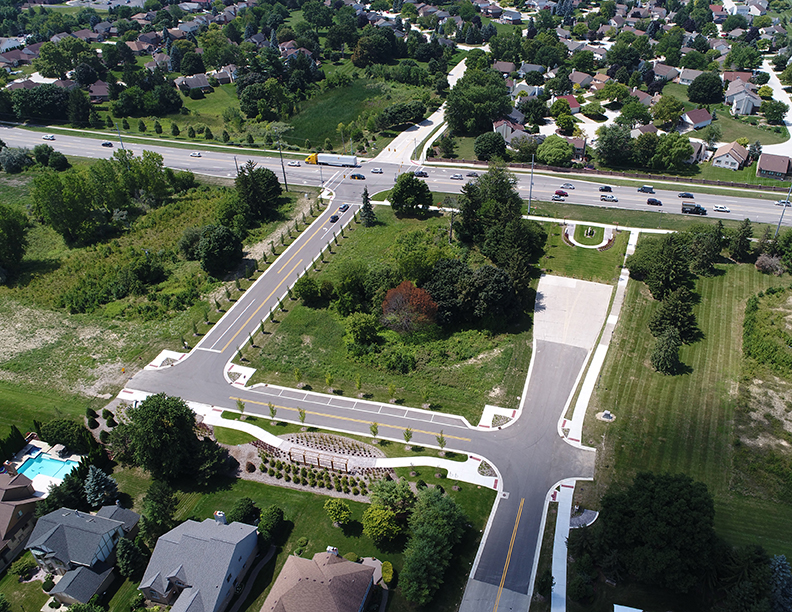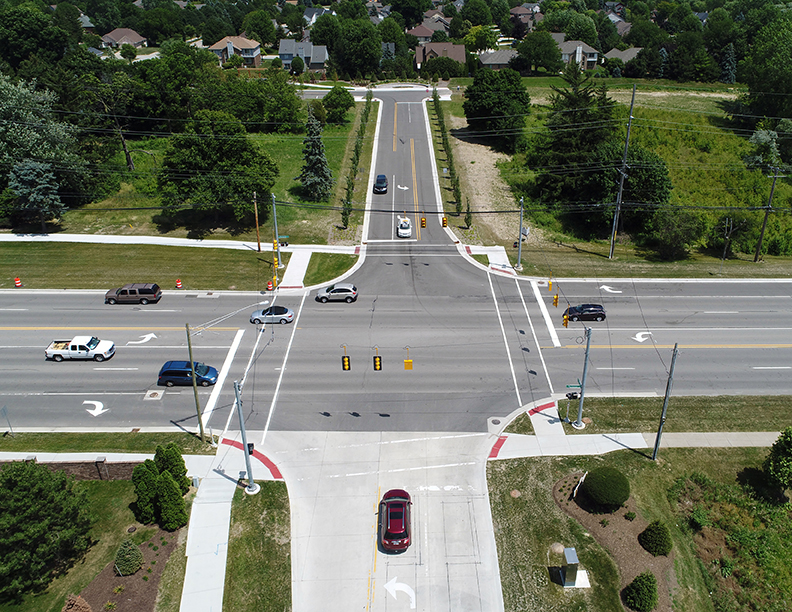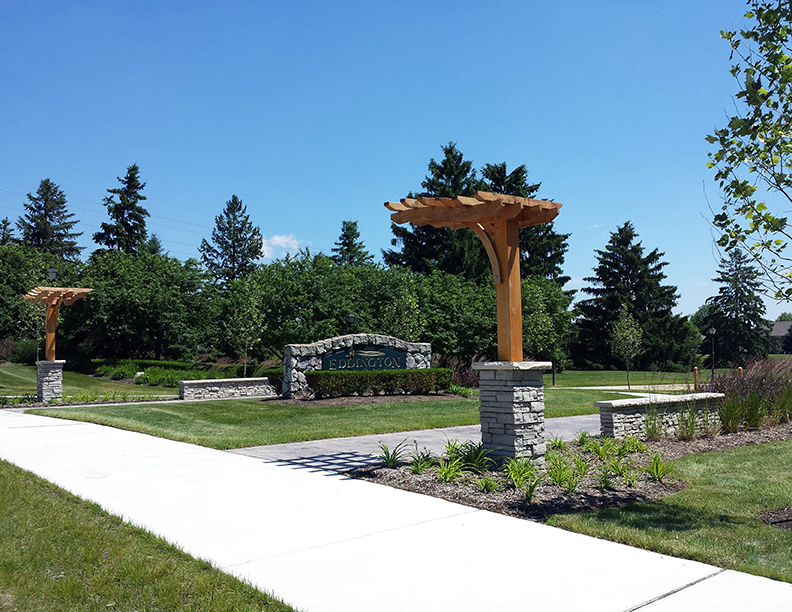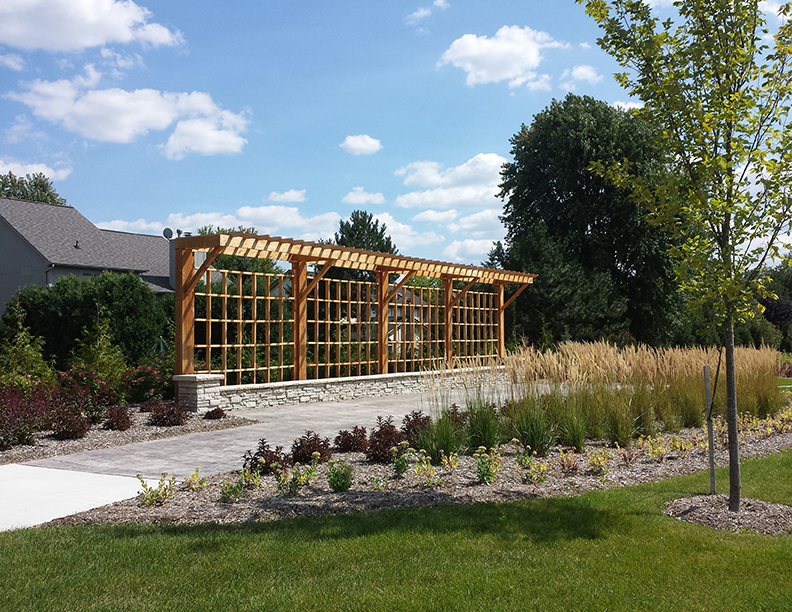Community: City of Rochester Hills
Population: 10,000+
This intergovernmental cooperation project was conceived through a public/private partnership where the developer entered into a PUD agreement with the City of Rochester Hills. To the west and east of Rochester Road are residential subdivisions. Each subdivision had its own entrance road with no traffic signal. Drexelgate Parkway was to the west and Eddington Boulevard was to the east with approximately 1,000 feet between the roads. Due to large traffic volumes along Rochester Road, acceptable gaps to make left turns were infrequent during the day and posed safety concerns. Through community engagement and the PUD agreement, the boulevard on Drexelgate was eliminated in favor of a three-lane roadway connection to Rochester Road. Existing Eddington Boulevard was eliminated and converted into a park while the new Eddington was aligned with Drexelgate to create a four-way intersection with a traffic signal. Landscape features and screening were used to further enhance the neighborhoods.
Replicability:
This project is one that any city could easily replicate by having a willingness to think big and bold, have the fortitude to partnering with multiple stakeholders, and have the vision to think beyond a single project. First the city needs to start with the impacted property owners by understanding their needs and wants and how those desires align with the City’s Master Plan. This first step should start early and be facilitated through a robust community engagement process. As the project concepts begin to be finalized and the developer and City agree on project scope, a public/private partnership needs to be formalized through a Planned Urban Development (PUD) agreement. When drawing up a PUD agreement, all city departments need to be involved in reviewing the project from each department’s perspective. If any part of the project is under the jurisdiction of another agency, such as county and/or state, those agencies will need to weigh in and plans designed with their requirements. After all the aforementioned is addressed and considered, an engineering consulting firm needs to be hired to coordinate, facilitate, perform and develop the plans and specifications associated with all aspects of the project: roadway alignment, signal design, landscape elements, pavement surfaces and project finishes. Upon completion of the plans and specifications, the project needs to be bid in accordance with the procurement ordinance as well as being bid at a time of the year where the project can be completed in one construction season and where the owner will received the most favorable pricing. These plans in turn need to be coordinated and combined with the engineering design plans for bid letting. A contractor needs to be chosen through the bidding process, and will sequentially hire several subcontractor vendors whom specialize in the trades needed. And lastly, a construction engineering company needs to be retained to administer the project, and most importantly, needs to collaborate/communicate effectively with all stakeholders, HOA presidents, residents, city officials and staff, contractors, and engineers throughout the construction period.
Creativity and Originality:
The City of Rochester Hills tends to have heavy traffic issues especially on Rochester Road which is under MDOT jurisdiction. The City was very creative to bring the developer, homeowners, MDOT, and City departments (Mayor’s Office, Planning, Building, DPS and City Council) together to implement a viable solution to keep the identity of the two neighborhoods, for the developer with future developments and to keep traffic moving on Rochester Road. Nothing like this had been done before in the City. In addition, the City was very innovative in how they communicated with the public. During construction, weekly project updates were sent out through email to all subscribed stakeholders, HOA presidents, residents, city officials and staff, contractors, and engineers to keep them well-informed of the progress. This was a win-win situation for everyone involved and cut down drastically on the number of calls the City received during construction, so much so that the City demands this on every construction project.
Community Impact:
The City and various stakeholders put much thought into and analyzed every angle of the project so the community would be impacted in a positive way. This was achieved through implementing access management, traffic calming elements, landscape enhancements, corridor development, and walkability. Access management was achieved through the PUD agreement. Any new development on Rochester Road would be entered from Eddington Boulevard, keeping traffic moving on Rochester Road. Traffic calming elements included aligning an offset intersection, dedicated turn lanes and adding a traffic signal. The old Eddington Boulevard was converted into a community park with landscape features to preserve the identity of the subdivision. Both the new Eddington and Drexelgate neighborhoods were enhanced with landscape feature to define the entry into each subdivision. The corridor along the new Eddington Boulevard was enhanced with trees and a linear park to act as a barrier between future developments and the subdivision. Pathway connections were made providing connectivity to regional pathways and community services for both walkers and bikers. All of these elements defined the subdivisions and provided residents piece of mind when entering and exiting their neighborhood where previously dangerous conditions existed.



